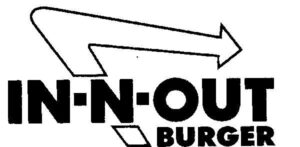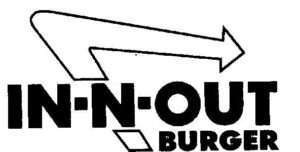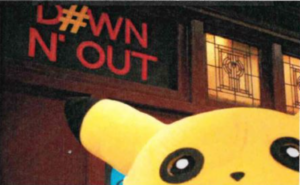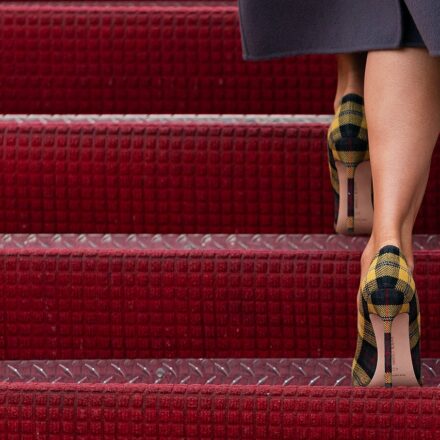Whilst In-N-Out don’t operate any permanent restaurants in Australia – only pop-ups, as we lamented in our previous post – the Federal Court ruled last week that its registered trade marks had been infringed by local chain “Down-N-Out” (DNO) and that In-N-Out had a sufficient reputation in Australia such that DNO was found to be passing-off and in contravention of the Australian Consumer Law.
The first line of Justice Katzmann’s (…380 paragraph long) judgment neatly captures the key issue:
What is the line between inspiration and appropriation? That is the question at the heart of the dispute in the present case.
The case provides a nice illustration of the dangers in overtly taking aspects of a reputed brand, particularly in a market in which inspiration is frequently taken from overseas brands.
In-N-Out, In-N-Out. That’s what a hamburger’s all about
In-N-Out Burger (or more commonly known as simply In-N-Out) is a chain of fast food restaurants serving burgers and complementary menu – and a not-so-secret secret menu – items in locations primarily based in the United States. In Australia, it only showcases its business through pop-up events but owns a number of registered trade marks, including the below:
(the “In-N-Out Marks”).
Many will be familiar with the red and yellow composite mark (though we note that colour schemes for the purposes of trade marks can be immaterial since the In-N-Out Marks are registered without limitations as to colour and therefore taken to be registered for all colours):

This logo is prominently displayed on signposts located in the vicinity of many of its fast food restaurants and drive-through. As noted in the judgment, there’s one right near LAX and one or more of the IP Whiteboard team may or may not have scoffed a Double-Double at the Sunset Boulevard location (with fries ‘well done’, obvs).
Feast your eyes on this – the respondents’ conduct
DNO comprises Hashtag Burgers Pty Ltd, Benjamin Kagan and Andrew Saliba.
In June 2015, Messrs Kagan and Saliba held a “Funk n Burgers” pop-up burger event. It happened to be after the fourth In-N-Out pop-up event and utilised the below logo:
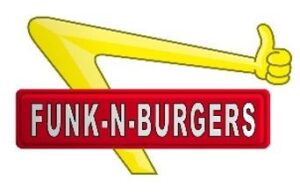
You can see why In-N-Out weren’t pleased, particularly when the graphic designer was instructed to make “a funk n burgers sign like in n out burger” and the Facebook promo for the event said:
This time on the menu we have the legendary In’N’Ou … I mean the Down’N’Out burger served up ANIMAL STYLE for all you fatties. Go single or double‑double that sexy MOFO.
And later, when they were advertising another pop-up event on Facebook:
WE ARE BACK FOR 2016!! To kick of[f] the new year we are bringing back the MOST POPULAR burger from last year … the In-N-Ou..*cough* I mean … Down-N-Out Burger – served ANIMAL STYLE for all you fatty boombas!
And if that wasn’t enough, every burger will be accompanied by ANIMAL STYLE fries with liquid cheese! Hrrrrrggggggggg…
Still not satisfied? DOUBLE-DOUBLE that sucka and turn your meal into a heart attack on a plate.
Later in 2016, Messrs Kagan and Saliba decided to pull the trigger on a pop-up burger restaurant, utilising the “cheekily named” DOWN-N-OUT name and a sign that used the exact same colour scheme as In-N-Out.
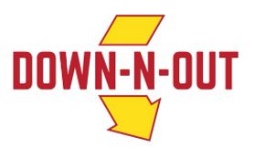
In an email, Mr Kagan remarked that DNO had become “Sydney’s most controversial burger restaurant”.
This branding prompted In-N-Out to write to Messrs Kagan and Saliba, acknowledging it was “flattered” that they had conducted the events, and politely requesting them to stop using its trade marks and to select a different name and logo which would sufficiently distinguish their business from In-N-Out so as to avoid confusion.
Mr Kagan replied, acknowledging “ANIMAL STYLE” and “PROTEIN STYLE” to be “trademarked terms” but insisting they were not trying to deceive customers or “rip-off” the In-N-Out brand, claiming:
This expression [Down-N-Out] has its own separate and distinct meaning in the English language which is unlikely to conflict with the meaning of “In-N-Out”. Further, the word Down also relate to “Down Under” which relates to the fact that we are an Australian business.
Nonetheless, Mr Kagan said he understood the concerns about the logo and a number of variations to the original logo started to appear – most notably:
- changes to the hyphens and an inclusion of an apostrophe;
- and subsequently, the “O” in “Down” being replaced by a hashtag:
Since then, the respondents’ business has grown significantly across Sydney, with restaurants opened in Penrith, Ryde, Sydney CBD, Wollongong and Crows Nest.
The trade mark infringement claim
In-N-Out claimed that the use of the names and trade marks “DOWN-N-OUT”, “DOWN N’ OUT” AND “DOWN N OUT”, as well as the “downnout” domain name and logo infringed its registered marks. There was no dispute that the respondents used these signs as trade marks in relation to goods and services in respect of which the marks were registered for In-N-Out. The issue was whether any of the respondents’ trade marks were deceptive similarly to In-N-Out’s registered trade marks. It was agreed that if the name “Down-N-Out”, in whatever form, was deceptively similar to the name “In-N-Out”, then In-N-Out would succeed in its trade mark infringement claims as against all the DNO marks.
Even though the respondents claimed that the hashtag provided a “material point of distinction” from the In-N-Out Marks, Justice Katzmann did not accept the submission. The natural way to pronounce D#WN N’ OUT is “down n’ out” (and # is not a click consonant).
The respondents claimed that the names were not deceptively similar for the following reasons:
- the names do not convey the same idea or impression;
- the marks incorporate important visual differences;
- the marks do not sound alike;
- the marks begin differently and the first syllable generally should be given greater weight and significance;
- the essential features of the marks are different; and
- no witnesses were called to give evidence that they were confused as a result of the use of the marks in relation to the respondents’ goods and services.
Seeing DOUBLE DOUBLE – not quite, but the marks were deceptively similar
Justice Katzmann considered there was a resemblance between the marks, and that the resemblance was so close as to likely cause confusion or deception.
Her Honour considered that the impression the impugned mark would have on consumers of ordinary intelligence with an imperfect recollection of the registered marks was what mattered. In assessing this, her Honour found that there was a clear visual and aural resemblance between the marks as they all finish with ‘N’ followed by ‘OUT’ and appear in sans serif fonts.
Her Honour, although accepting that the meanings of “down and out” and “in and out” can be different, noted that meanings can change according to context. The respondents’ marks were being used in respect of the same kind of goods and services as In-N-Out, and the directional terms (“in”, “out”, and “down”) would not by deconstructed by an ordinary consumer.
As part of the assessment as to the likelihood of confusion, the Court considered In-N-Out’s evidence gathered from social media posts on Instagram and Facebook.
Whilst evidence of actual confusion can be very persuasive, Her Honour noted it was always necessary to evaluate the quality of the evidence; in this case, it was difficult to put a great deal of weight on the evidence because there was an absence of context, no ability to identify the people who posted the remarks, and none of the authors of the posts gave evidence.
However, in order to establish the likelihood of deception or confusion and succeed under its infringement claim, it was not necessary for In-N-Out to adduce evidence that anyone was in fact deceived or confused as the test is objective. The social media posts had some probative value and Messrs Kagan and Saliba did not take any steps to dispel the possibility of confusion – rather, they seemed happy to leave the question hanging. This, combined with the respondents’ “cheeky” behaviour, led to her Honour concluding that it was no coincidence that Messrs Kagan and Saliba settled on the name DOWN-N-OUT; the respondents had adopted the name “Down-N-Out” for their burger business for the purpose of appropriating part of In-N-Out’s reputation and, potentially, its trade. Her Honour found that the respondents sought to attract potential customers by having them wonder whether DOWN-N-OUT was, indeed, a down-under version of IN-N-OUT or, at least, that the two were connected or allied in some way – and in doing so, “sailed too close to the wind”. This was based on a case regularly cited in decisions of this nature, namely Australian Woollen Mills in which Dixon and McTiernan JJ of the High Court held that:
The rule that if a mark or get-up for goods is adopted for the purpose of appropriating part of the trade or reputation of a rival, it should be presumed to be fitted for the purpose and therefore likely to deceive or confuse, no doubt, is as just in principle as it is wholesome in tendency. In a question how possible or prospective buyers will be impressed by a given picture, word or appearance, the instinct and judgment of traders is not to be lightly rejected, and when a dishonest trader fashions an implement or weapon for the purpose of misleading potential customers he at least provides a reliable and expert opinion on the question whether what he has done is in fact likely to deceive.
The respondents were found to have infringed the In-N-Out Marks.
The Australian Consumer Law claims
In-N-Out submitted that by using the impugned marks to advertise, market or promote their goods and services at various venues, the respondents sought to “mimic” the In-N-Out goods and services in contravention of section 18 of the Australian Consumer Law (ACL). In addition, In-N-Out relied on the alleged resemblance between In-N-Out’s menu items and those offered by the respondents, as well as the adoption of In-N-Out’s feature of a ‘secret menu’.
There was no dispute that the respondents’ conduct occurred in trade or commerce in connection with the supply of goods or services.
In-N-Out acknowledged that it would be enough if it could establish that the respondents had represented that there was an association between them and In-N-Out.
Not small fry – In-N-Out’s reputation
Firstly, her Honour considered In-N-Out’s reputation in Australia. For traders like In-N-Out that have no permanent presence in Australia, evidence of overseas reputation is admissible and may be probative.
Her Honour accepted there was extensive evidence about the popularity of In-N-Out and the brand’s notoriety in the United States which may have spilled over to Australia. In fact, the major giveaway was the fact that In-N-Out’s reputation was the very platform from which the respondents launched their first pop-up, using the In-N-Out brand as bait in their advertising campaign.
By contrast, there was no evidence to indicate that the name “Hashtag Burgers”, the name of the company established by Messrs Kagan and Saliba, was known by a substantial or significant number of consumers at any relevant time.
I got a hangover, whoa!
Justice Katzmann then methodically considered six categories of DNO’s conduct and assessed whether this was misleading or deceptive or likely to mislead or deceive a not insignificant number of members of the relevant class of consumer (agreed to be “those members of the public who have been, are or may be in the future interested in acquiring burgers and associated food/beverages and related restaurant services”) into thinking that there was an association of some kind between In-N-Out and the people behind DOWN-N-OUT.
To come to her conclusions, Justice Katzmann considered the “hangover” effect: when a change so subtly shaded might well escape the attention of a potential customer already imbued with the existing message such that the impression originally gained might be reinforced by the repetition of a closely similar message, not corrected. That is, the respondents had already represented there was an association between them and In-N-Out through their earlier conduct, and subsequent conduct served to reinforce this proposition, rather than correct it.
The passing-off claim
The passing-off claim rested upon the same conduct as that that gave rise to claim for contraventions of the ACL.
In-N-Out submitted that the reputation and goodwill of its branding provides it with “a real commercial position or advantage” in Australia, and it had been damaged by the misrepresentations made by the respondents. While there was no evidence to establish that In-N-Out suffered any actual damage, In-N-Out asserted it would be entitled to damages under the “user principle” where loss was suffered on the basis of a reasonable royalty or licence fee in respect of the respondents’ use of the registered trade marks. Given the Court was able to rely upon the same conduct as the ACL claims, and the judgment was dealing solely with liability, Justice Katzmann was satisfied that passing-off was made out.
A moment on the lips, but are they joined at the hips – liability of the second and third respondents
Passing-off is a common law tort, whilst trade mark infringement is a statutory tort. Justice Katzmann considered whether Messrs Kagan and Saliba were joint tortfeasors with Hashtag Burgers to render them jointly and severally liable with the company, and ultimately determined they were not because it could not be proven that the company was formed for the purpose of doing a wrongful act. Whilst both Messrs Kagan and Saliba were knowingly involved in the company’s wrongdoing, the evidence did not disclose the nature or extent of their involvement. There was no evidence that, after the incorporation of the company, either of them knew or believed that the use of the DOWN-N-OUT name or logos was infringing or likely to infringe; rather, there was evidence to suggest that they had obtained legal advice to the contrary. Therefore, it could not be said that they had intentionally or recklessly infringed the rights of In-N-Out.
However, Messrs Kagan and Saliba were found to be jointly and severally liable for the company’s contraventions of the ACL.
Key takeaway (and we’ll have fries with that)
Ultimately, In-N-Out successfully made out its case against DOWN-N-OUT for trade mark infringement, passing-off and for contraventions of the ACL. This provides a valuable lesson for parties seeking to use part of the brand and reputation of another company as inspiration for its own marketing and promotional activities. It is therefore prudent to question, in the apt words of Justice Katzmann – what is the line between inspiration and appropriation?





